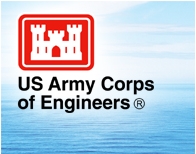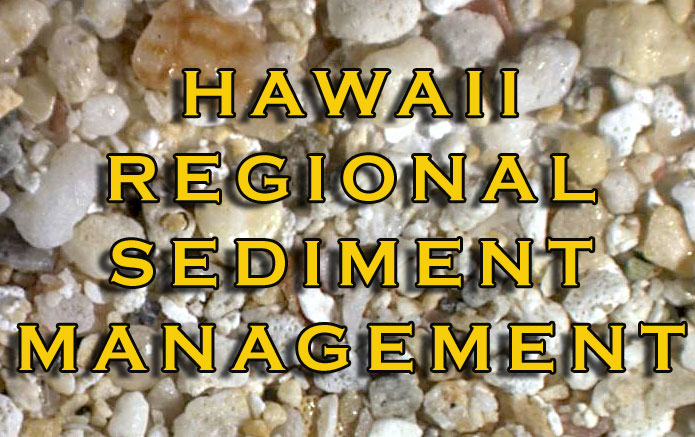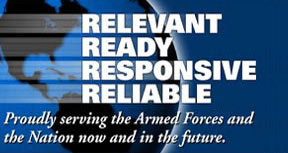Welcome and Introductions (Tom Smith and Sam Lemmo)
Tom Smith welcomed the workshop participants to the fourth and final workshop. He introduced Sam Lemmo, who explained that southeast Oahu is a unique area and an understanding of the sedimentation of the region is needed to understand shoreline change, sand budget, and sand sources, and to develop economical solutions. Mr. Lemmo described the three previous workshops.
Southeast Oahu Regional Sediment Management Overview (Tom Smith)
Tom Smith continued by providing an overview of the SEO/RSM and the topics that would be covered in the workshop. The RSM is an integrated approach from mountains to sea and from Mokapu Peninsula to Makapu'u Point. The final products of the SEO/RSM are shoreline change maps, sediment budget, modeling, GIS, demonstration projects, and an RSM plan. He mentioned the potential demonstration projects at Kaupo, Kaiona, Bellows, Lanikai, and Ka'elepulu Stream and provided photos of those shorelines.
Field Investigations
Wave and Current Data Collection (Jessica Podoski)
Jessica Podoski presented a description of the data collection program undertaken by the USACE in August and September of 2005. Five weeks of data were collected using three ADVs, 2 ADCPs, and drogues. The CDIP wave buoy was used to determine the input conditions. Wave and current results were presented.
Shoreline Change Analysis (Brad Romine)
Brad Romine presented his results of the shoreline change analysis. He explained that he used historical aerial photographs, using the beach toe as the SCRF (shoreline change reference feature). The shoreline was divided into 20 meter intervals and the change along the SCRF was measured. The data was analyzed using the EX model and the EXT model, which includes acceleration. He explained how to interpret the results. Tom Smith asked which method would be better to use in developing a sediment budget. Mr. Romine explained that EX is better for identifying the long-term trend, while the EXT is better as showing more recent trends. The areas covered by this work are Kailua, Lanikai, Waimanalo, Kaiona, Kaupo, and Makapu'u.
Offshore Sand Sources and Sediment Trend Analysis (Chris Bochicchio)
Chris Bochicchio briefly presented his findings on sediment sources from Kailua Bay through Waimanalo Bay, showing locations and estimated volumes. The largest volume of sand is found in the Kailua sand channel. There were also karst deposits and sand fields throughout the study area.
He continued with a discussion of sediment trend analysis (STA). He explained how sediment size distributions could be interpreted to provide direction and intensity of sediment transport. He presented a color contour plot showing the shoreline change at Bellows and Lanikai. He pointed out that erosion in the location of the Bellows revetments preceded accretion at Lanikai by several years, and then following revetment construction at Bellows, Lanikai experienced erosion. The figure also showed how trends in the shoreline change could be tracked alongshore with time. He also presented a time series plot of weekly average wind direction which showed that the tradewinds have a tendency to oscillate between northeast and east over several years (or longer).
Numerical Modeling Results
Water Circulation and Wave Transformation (Jessica Podoski)
Jessica Podoski presented the water circulation modeling results that were performed using ADCIRC. The currents in the SEO region, modeled under tide and tradewind conditions, are not very strong, and along Lanikai, the currents are typically toward the north. A gyre was found in Kailua Bay. Animations were shown.
She continued with the wave modeling results from STWAVE. The input conditions were wave heights measured by the CDIP wave buoy for 2000 through 2004. The model results were compared with the data collected during the 2005 field experiment. The model included bottom friction as an input, and this value was iterated to determine which value produced the best data fit. A value of n = 0.2 (Manning’s n) gave good correlation with the measured data, and this was a big improvement over n=0. It was also important to include tide in the model. Comparison with the JONSWAP friction coefficient produced similar results.
Regional Sediment Budget (Tom Smith)
Tom Smith presented his sediment budgets for SEO. The calculations were based on the shoreline change analyses presented by the UH Coastal Geology Group and wave modeling results produced by the USACE. He began his analyses at the northern extent of Kailua Beach and worked southward to Makapu'u Point.
Mr. Smith pointed out sand sources, sinks, and the limits of littoral cells, which all played roles in the sediment budget. He asked for a discussion of his assumptions as he presented the analyses. In general, there were questions about how much sand, if any, moves around Alala Point between Kailua Bay and Lanikai, and around Wailea Point between Bellows AFS and Lanikai.
SEO/Regional Sediment Management Focus Areas
Kaupo and Kaiona Beaches (Tom Smith)
Tom Smith presented Kaupo Beach as having unstable shoreline along Kalaniana'ole Highway. DOT installed piles in 2006 to mitigate the erosion threat against the road. This stretch of beach is not believed to be able to hold a beach without structures, so Mr. Smith declared that there was nothing USACE could do at that site.
He continued with Kaiona Beach, which still has a generally sandy shoreline. Some of the properties south of Kaiona Beach Park contain seawalls and north of the beach park, the beach has eroded close to the road. He did not see much potential for a demonstration project at this location.
Ka'elepulu Stream (Chip Fletcher)
Dr. Fletcher discussed the situation at Kailua Beach Park, including the erosion on the north side of the boat ramp and the sand buildup in the Ka'elepulu Stream mouth.
The City is considering removing the sand grabbers, which have become exposed over the past two years. There is concern whether this would threaten the parking lot inshore. If so, should the parking lot and Ironwood trees be sacrificed to allow the natural progression of the shoreline to occur? He presented that the erosion trend was moving northward.
Will Ho of the C&C Dept. of Parks and Recreation reported that the City’s plan for managing the Ka'elepulu Stream mouth was to clear it monthly and the sand is piled on the banks adjacent to the stream. The stream mouth fills back in within a few days. State Dept. of Health regulations prohibit placing the sand at any other location on the beach. A heavy rain event might flush the sand back into the littoral system; however, there may not be enough flow, due to re-routing of water out Kawainui Stream. He also noted that the sand is finer than when he was a kid and that the sand has migrated inshore up the stream.
Dr. Fletcher reported on a sand field containing 50,000 to 100,000 cubic yards of sand that is not within the littoral zone and could be mined for beach nourishment.
Ideas that were discussed were removal of the boat ramp, new Best Management Practices, and a focus group to address the stream mouth.
DLNR is conducting a Kailua dune and beach management plan study. Scope of work includes study of sand processes, vegetation, etc.
Tom Smith offered that possibility of their 1135 authority, which would provide the first $100,000 to study the situation. A representative from Congresswoman Hirono’s office offered their assistance.
Bellows AFS (David Smith)
David Smith presented three conceptual plans for shoreline restoration at Bellows AFS. The first involved nourishing the beach by following the last stable shoreline (1987) with a minimum dry beach width of 30 feet. The second concept involved nourishing only in front of the revetments, as the southern portion of the shoreline did not need nourishing. This concept required significantly less sand. The third concept showed the effect of removing the revetment and the subsequent equilibrium shoreline location. At this location, there were several buildings that would be threatened by erosion.
Lanikai Beach (David Smith)
David Smith presented two conceptual plans for shoreline restoration at Lanikai Beach. The first concept involved nourishing the beach without the use of structures. This concept produced a 30-foot dry beach width. The second concept involved building tuned T-head groins and nourishing between the groins to produce a more stable beach. This concept produced arc-shaped beach cells with a desired minimum width of 30 feet.
Estimated costs were presented, with Concept 1 requiring renourishment every 8 to 9 years. This greatly increases the cost over 50 years. The 50 year cost for Concept 1 was estimated to be $109,000,000 versus the estimated $42,000,000 for Concept 2.
A question was asked regarding the ability to walk along the beach without obstruction. Dr. Smith replied that the dry beach area was one foot higher than the groin crest elevation. This would produce a continuous walking area with a minimum width of 30 feet, expanding to approximately 100 feet near the groins. Another question was asked regarding the effects of turbidity if the beach was nourished with offshore sand. Dr. Smith replied that the sand mined from the reef flat would likely not cause turbidity problems because the sand is already in a dynamic environment and fines would have been already removed from the sand. Additionally, matching the source sand to the native sand alleviates such concerns.
Tom Smith continued by introducing the Lanikai Beach Restoration Pilot Project. This would involve design of a two-groin system with beach nourishment. The groins would be made of a “soft” material such as a geotextile filled with sand and would be considered temporary. The project site would be centered at the beach access across from Pokole Way.
Future Work (Tom Smith)
Tom Smith presented a list of future work that builds upon the SEO/RSM. Work included investigating sand mining from Ka'elepulu Stream, the Lanikai Beach Restoration Pilot Project, review of the SEO sediment budget, updating of the RSM plan, and preliminary development of a Maui RSM plan.
The participants were thanked and the workshop was adjourned.


